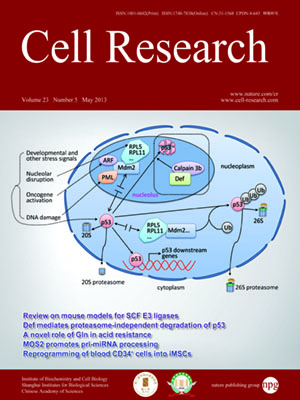
Volume 23, No 5, May 2013
ISSN: 1001-0602
EISSN: 1748-7838 2018
impact factor 17.848*
(Clarivate Analytics, 2019)
Volume 23 Issue 5, May 2013: 691-704
ORIGINAL ARTICLES
Caspase-mediated cleavage of C53/LZAP protein causes abnormal microtubule bundling and rupture of the nuclear envelope
Jianchun Wu1,*, Hai Jiang2,*, Shouqing Luo3, Mingsheng Zhang4,5, Yinghua Zhang4, Fei Sun6, Shuang Huang4 and Honglin Li4
1Cancer Center, University of Illinois at Chicago, Chicago, IL 60612, USA
2Shanghai Institute of Biochemistry and Cell Biology, Shanghai 200031, China
3Cambridge Institute for Medical Research, Department of Medical Genetics, University of Cambridge, Cambridge CB2 0XY, UK
4Department of Biochemistry and Molecular Biology, Cancer Center, Georgia Health Sciences University, Augusta, GA 30912, USA
5Department of Oncology, Tongji Hospital, Tongji Medical College, Huazhong University of Science & Technology, Wuhan 430030, China
6Department of Physiology, Wayne State University, Detroit, MI 48202, USA
Correspondence: Honglin Li,(hli@gru.edu)
Apoptotic nucleus undergoes distinct morphological and biochemical changes including nuclear shrinkage, chromatin condensation and DNA fragmentation, which are attributed to caspase-mediated cleavage of several nuclear substrates such as lamins. As most of active caspases reside in the cytoplasm, disruption of the nuclear-cytoplasmic barrier is essential for caspases to reach their nuclear targets. The prevailing proposed mechanism is that the increase in the permeability of nuclear pores induced by caspases allows the caspases and other apoptotic factors to diffuse into the nucleus, thereby resulting in the nuclear destruction. Here, we report a novel observation that physical rupture of the nuclear envelope (NE) occurs in the early stage of apoptosis. We found that the NE rupture was caused by caspase-mediated cleavage of C53/LZAP, a protein that has been implicated in various signaling pathways, including NF-κB signaling and DNA damage response, as well as tumorigenesis and metastasis. We also demonstrated that C53/LZAP bound indirectly to the microtubule (MT), and expression of the C53/LZAP cleavage product caused abnormal MT bundling and NE rupture. Taken together, our findings suggest a novel role of C53/LZAP in the regulation of MT dynamics and NE structure during apoptotic cell death. Our study may provide an additional mechanism for disruption of the nuclear-cytoplasmic barrier during apoptosis.
Cell Research (2013) 23:691–704. doi:10.1038/cr.2013.36; published online 12 March 2013
FULL TEXT | PDF
Browse 2340


